Search Result
Results for "
Thyroid Inhibitors
" in MedChemExpress (MCE) Product Catalog:
2
Isotope-Labeled Compounds
| Cat. No. |
Product Name |
Target |
Research Areas |
Chemical Structure |
-
- HY-W010696
-
|
3′,5′,3-Triiodothyronine
|
Thyroid Hormone Receptor
|
Cardiovascular Disease
|
|
Reverse T3 is a thyroid hormone that can be generated by deiodination of the prohormone thyroxine . Reverse T3 inhibits the increase of sodium current generated by other thyroid hormone analogs in neonatal rat myocytes .
|
-
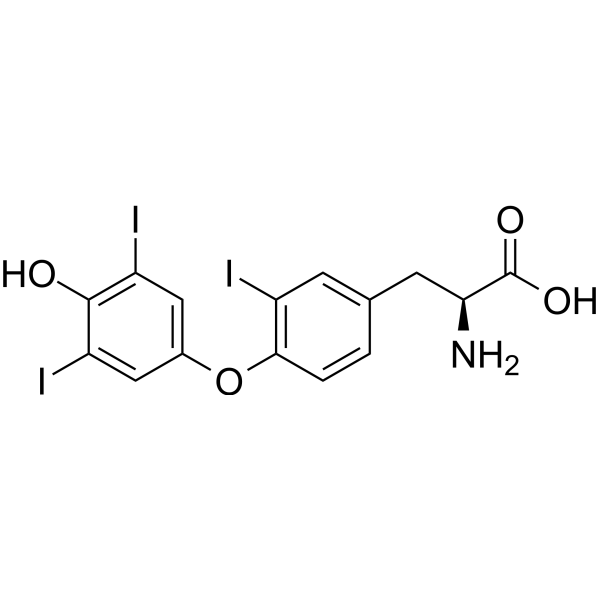
-
- HY-B1201
-
|
3,3',5-Triiodothyroacetic acid
|
Flavivirus
Thyroid Hormone Receptor
TNF Receptor
|
Endocrinology
|
|
Tiratricol is an orally available thyroid hormone analog that inhibits pituitary thyroid-stimulating hormone secretion. Tiratricol is an intracellular toxin neutralizer that inhibits LPS and lipid A cytotoxicity with IC50s of 20 μM and 32 μM, respectively. Tiratricol reduces TNF production in lipopolysaccharide-stimulated macrophages. Tiratricol also has antiviral activity and is an inhibitor of yellow fever virus (Flavivirus). It can bind to the RdRp domain of the viral NS5 protein to hinder YFV replication. .
|
-
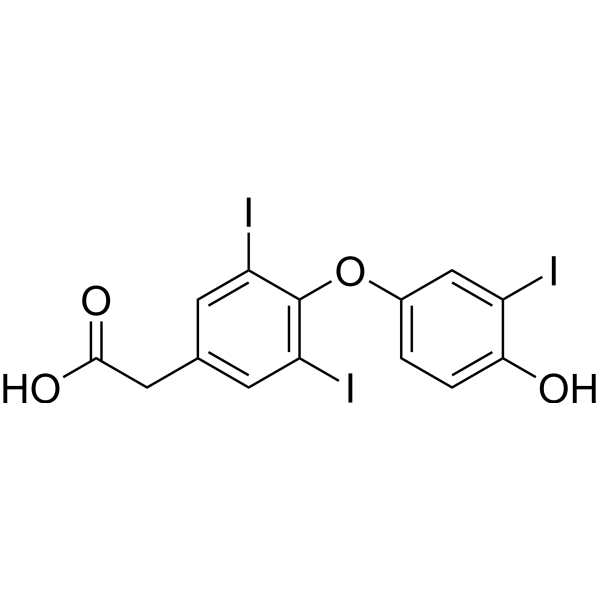
-
- HY-A0152
-
-
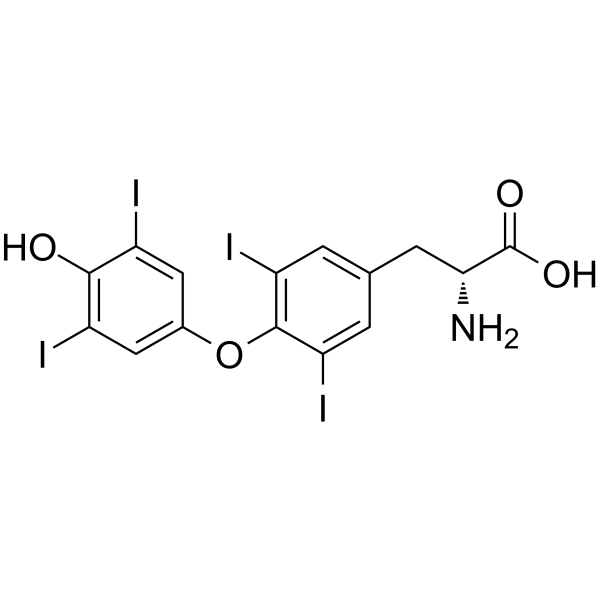
-
- HY-141513
-
NH-3
1 Publications Verification
|
Thyroid Hormone Receptor
|
Neurological Disease
|
|
NH-3 is an orally active, reversible thyroid hormone receptor (THR) antagonist with an IC50 of 55 nM. NH-3, a derivative of the selective thyromi-metic GC-1, inhibits binding of thyroid hormones to their receptor and that inhibits cofactor recruitment . NH-3 is a click chemistry reagent, it contains an Alkyne group and can undergo copper-catalyzed azide-alkyne cycloaddition (CuAAc) with molecules containing Azide groups.
|
-

-
- HY-N0224A
-
|
(S)-Goitrin; L-5-Vinyl-2-thiooxazolidone
|
Influenza Virus
|
Metabolic Disease
|
|
Goitrin ((S)-Goitrin), a product of glucosinolate-myrosinase reactions, is a potent inhibitor of thyroid peroxidase. Goitrin can inhibit iodine utilization by the thyroid. Goitrin also exhibits anti-influenza virus (H1N1) activity .
|
-
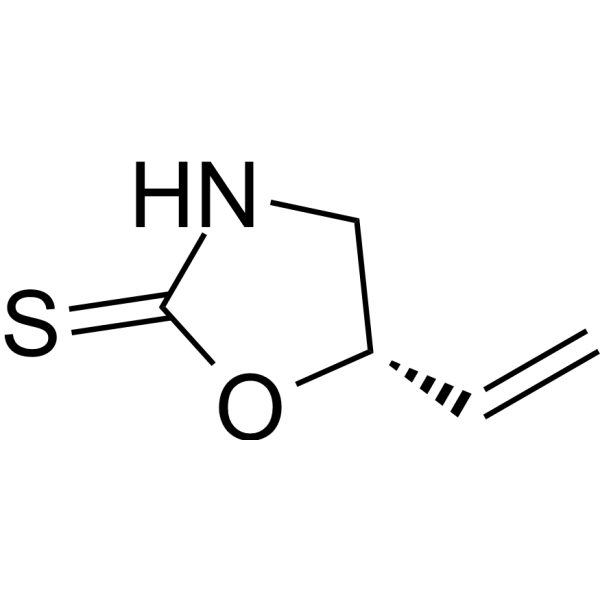
-
- HY-N6791
-
KT5823
3 Publications Verification
|
PKA
PKC
Bacterial
Apoptosis
Antibiotic
|
Infection
Inflammation/Immunology
|
|
KT5823, a selective the cGMP-dependent protein kinase (PKG) inhibitor with an Ki value of 0.23 μM, it also inhibits PKA and PKC with Ki values of 10 μM and 4 μM, respectively . KT5823 is a staurosporine-related protein kinase inhibitor, increases thyroid-stimulating hormone-induced (Na +/I - symporter) NIS expression, and iodide uptake in thyroid cells . KT5823 arrests cells after the G0/G1 boundary and causes increases in the levels of apoptotic DNA fragmentation .
|
-
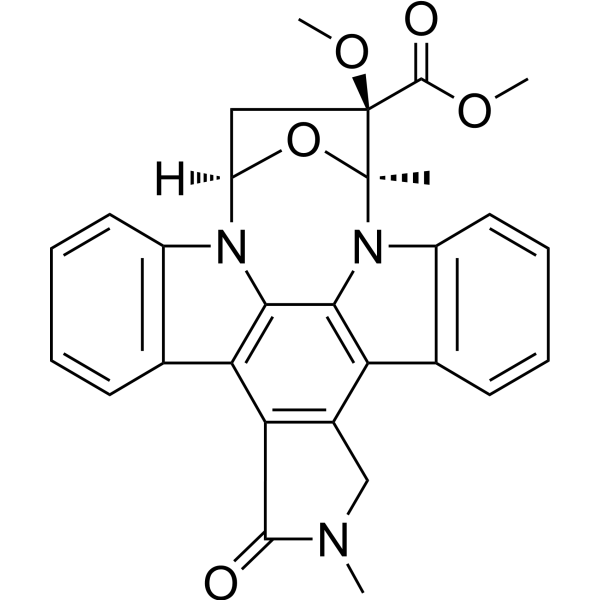
-
- HY-B1201R
-
|
|
Flavivirus
Thyroid Hormone Receptor
TNF Receptor
|
Endocrinology
|
|
Tiratricol (Standard) is the analytical standard of Tiratricol. This product is intended for research and analytical applications. Tiratricol is an orally available thyroid hormone analog that inhibits pituitary thyroid-stimulating hormone secretion. Tiratricol is an intracellular toxin neutralizer that inhibits LPS and lipid A cytotoxicity with IC50s of 20 μM and 32 μM, respectively. Tiratricol reduces TNF production in lipopolysaccharide-stimulated macrophages. Tiratricol also has antiviral activity and is an inhibitor of yellow fever virus (Flavivirus). It can bind to the RdRp domain of the viral NS5 protein to hinder YFV replication. .
|
-

-
- HY-115686
-
|
|
Adenosine Deaminase
|
Inflammation/Immunology
Cancer
|
|
8-Azaadenosine is a potent ADAR1 inhibitor and an A-to-I editing inhibitor. 8-Azaadenosine blocks RNA editing and inhibits proliferation, 3D growth, invasion, and migration in thyroid cancer cells .
|
-
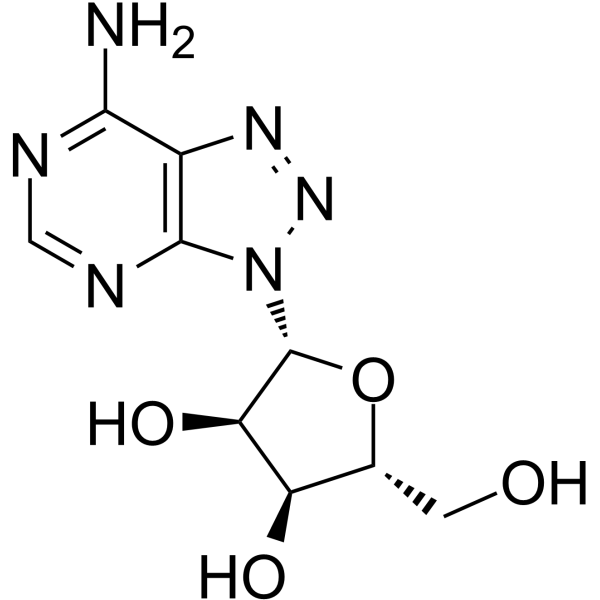
-
- HY-W011258
-
|
L-Tyrosyl-L-phenylalanine
|
Xanthine Oxidase
Angiotensin-converting Enzyme (ACE)
|
Inflammation/Immunology
Cancer
|
|
H-Tyr-Phe-OH (L-Tyrosyl-L-phenylalanine) is an orally active inhibitor of Angiotensin converting enzyme (ACE), with an inhibiton rate of 48% at 50 μM. H-Tyr-Phe-OH can be used as an biomarker for differentiating benign thyroid nodules (BTN) from thyroid cancer (TC). H-Tyr-Phe-OH exhibits xanthine oxidase inhibition (uric acid lowering) activity and serves as regulator in IL-8 production in neutrophil-like cells .
|
-

-
- HY-19980A
-
PRIMA-1
2 Publications Verification
NSC-281668
|
Autophagy
MDM-2/p53
Ferroptosis
Apoptosis
|
Cancer
|
|
PRIMA-1 (NSC-281668) is a mutant p53 reactivator, restores the sensitivity of TP53 mutant-type thyroid cancer cells to the histone methylation inhibitor 3-Deazaneplanocin A.
|
-
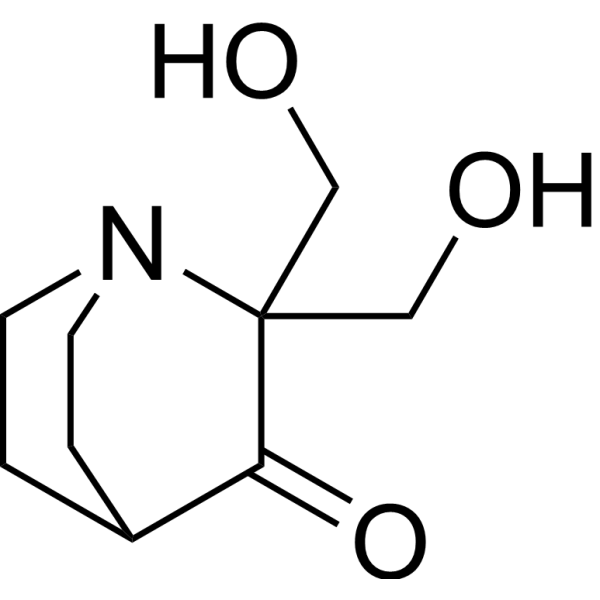
-
- HY-N0647
-
|
|
Monocarboxylate Transporter
|
Endocrinology
|
|
Silychristin is an abundant flavonolignan present in the fruits of Silybum marianum, with antioxidant properties. Silychristin is a potent inhibitor of the thyroid hormone transporter MCT8, and elicits a strong inhibition of T3 uptake with an IC50 of 110 nM .
|
-
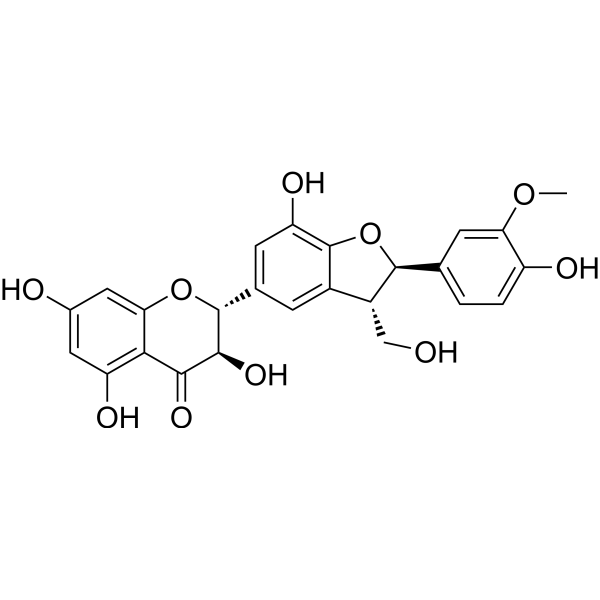
-
- HY-N6033
-
|
(+)-Ferruginol
|
EBV
HSV
Apoptosis
|
Infection
Cardiovascular Disease
Neurological Disease
Cancer
|
|
Ferruginol ((+)-Ferruginol), a natural diterpenoid, is an inhibitor of the activation of Epstein-Barr virus early antigen (EBV-EA). Ferruginol inhibits the growth of thyroid cancer cells through the induction of mitochondrial apoptosis. Ferruginol has antitumor, cardioprotective, antioxidant, gastroprotective, and neuroprotective activities .
|
-
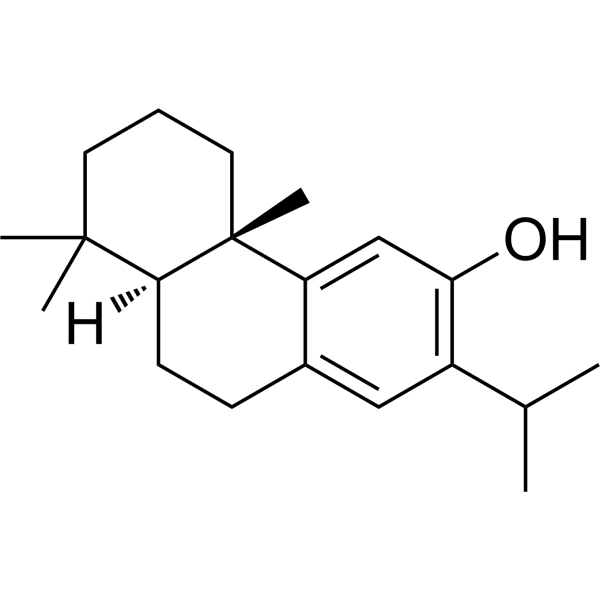
-
- HY-W008452
-
|
|
Endogenous Metabolite
|
Metabolic Disease
|
|
H-Tyr(3-I)-OH is a potent and effective tyrosine hydroxylase inhibitor. H-Tyr(3-I)-OH is an intermediate in the production of thyroid hormones and has a role as a human or mouse metabolite .
|
-
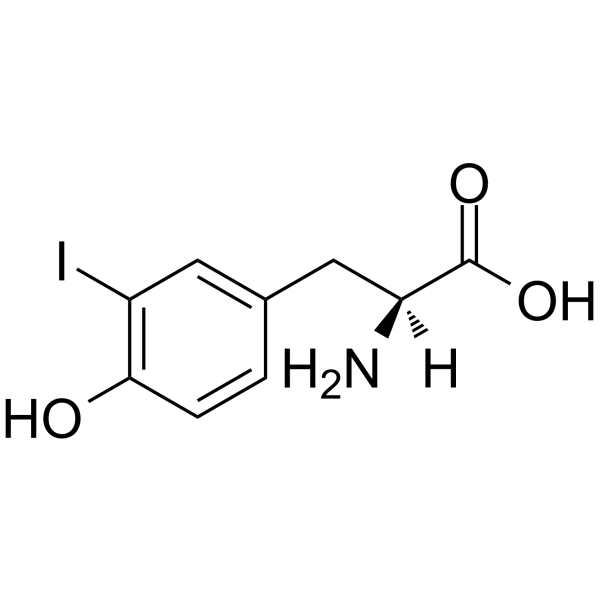
-
- HY-101246
-
|
|
RET
|
Cancer
|
|
RPI-1 is a specific, orally available 2-indolinone Ret tyrosine kinase inhibitor. RPI-1 inhibits proliferation, Ret tyrosine phosphorylation, Ret protein expression, and the activation of PLCgamma, ERKs and AKT in human medullary thyroid carcinoma TT cells. Antitumor activity .
|
-
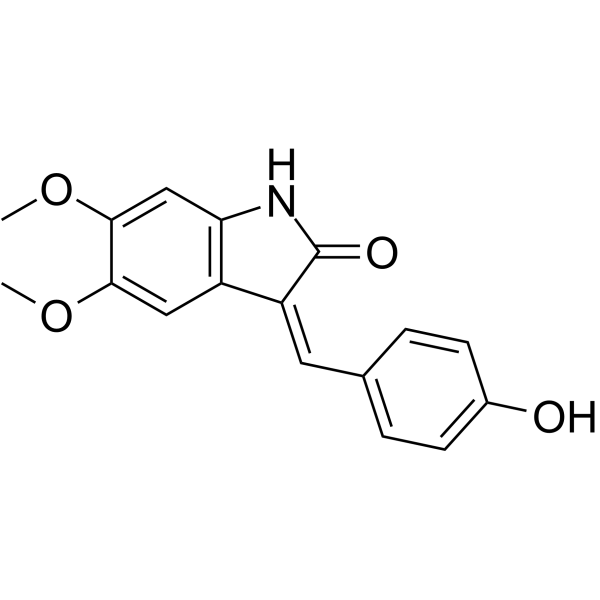
-
- HY-139915
-
|
|
Glutathione Peroxidase
|
Inflammation/Immunology
|
|
MPO-IN-1 is a potent, orally active, and irreversible indole-containing inhibitor of myeloperoxidase (MPO). MPO-IN-1 has IC50s of 2.6 μM and 5.3 μM for MPO and thyroid peroxidase (TPO), respectively. MPO-IN-1 inhibits MPO activity in an acute mouse model of inflammation .
|
-
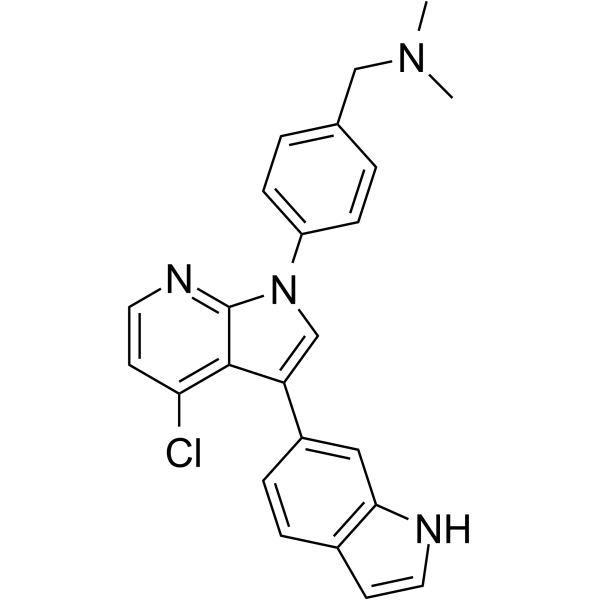
-
- HY-12753A
-
|
SR35021 hydrochloride
|
Thyroid Hormone Receptor
|
Cardiovascular Disease
|
|
Debutyldronedarone (SR35021) hydrochloride, the main metabolite of Dronedarone, is a selective thyroid hormone receptor α1 (TRα1) inhibitor. Debutyldronedarone hydrochloride inhibits T3 binding to TRα1 and TRβ1 by 77% and 25%, respectively. Debutyldronedarone hydrochloride can be used for the research of arrhythmic .
|
-
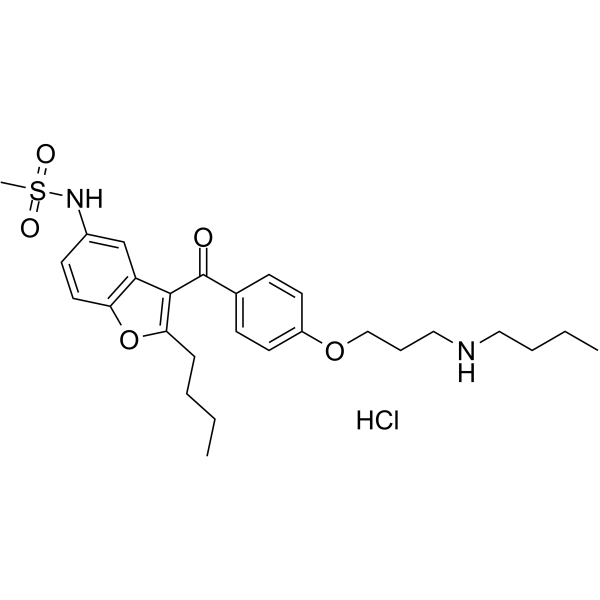
-
- HY-156113
-
|
|
RET
|
Cancer
|
|
RET-IN-25 (compound 6b) is a RET kinase inhibitor with anticancer activity. RET-IN-25 inhibits medullary thyroid carcinoma (MTC) with IC50s of 3.6 μM (3 days) and 3.0 μM (6 days) against TT(C634R) MTC .
|
-

-
- HY-Q04764
-
|
|
Thyroid Hormone Receptor
Apoptosis
|
Cancer
|
|
TI17 is an inhibitor of the thyroid hormone receptor-interacting protein Trip13 and has anticancer activity. TI17 effectively inhibits multiple myeloma (MM) cell proliferation and induces cell cycle arrest and apoptosis. Trip13 is an AAA-ATPase that mediates double-strand break (DSB) repair; TI17 inhibits Trip13 function and increases DNA damage .
|
-

-
- HY-156135
-
|
|
RET
|
Others
|
|
NSC194598 is a p53 DNA-binding inhibitor with IC50 value of 180 nM and 2-40 μM for in vitro and in vivo, respectively. NSC194598 interferes with transcriptional activation of mutated RET gene in human medullary thyroid carcinoma TT cells. NSC194598 can be used for acute toxicity to normal tissues by radiation and chemotherapy research .
|
-
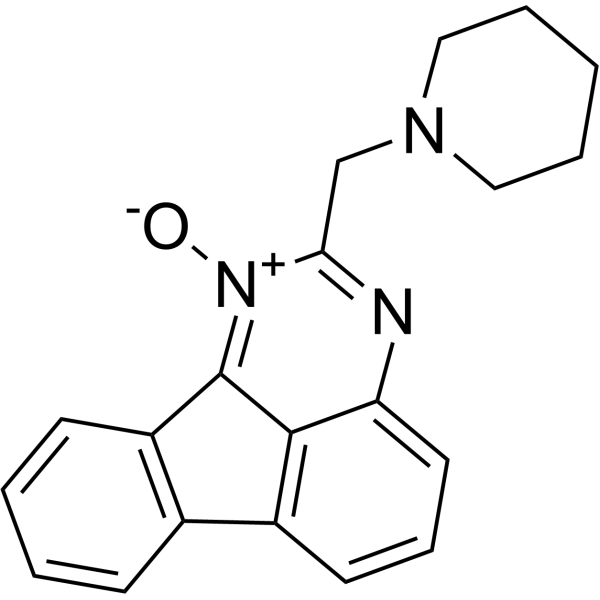
-
- HY-12753AR
-
|
SR35021 hydrochloride (Standard)
|
Thyroid Hormone Receptor
|
Cardiovascular Disease
|
|
Debutyldronedarone (hydrochloride) (Standard) is the analytical standard of Debutyldronedarone (hydrochloride). This product is intended for research and analytical applications. Debutyldronedarone (SR35021) hydrochloride, the main metabolite of Dronedarone, is a selective thyroid hormone receptor α1 (TRα1) inhibitor. Debutyldronedarone hydrochloride inhibits T3 binding to TRα1 and TRβ1 by 77% and 25%, respectively. Debutyldronedarone hydrochloride can be used for the research of arrhythmic .
|
-
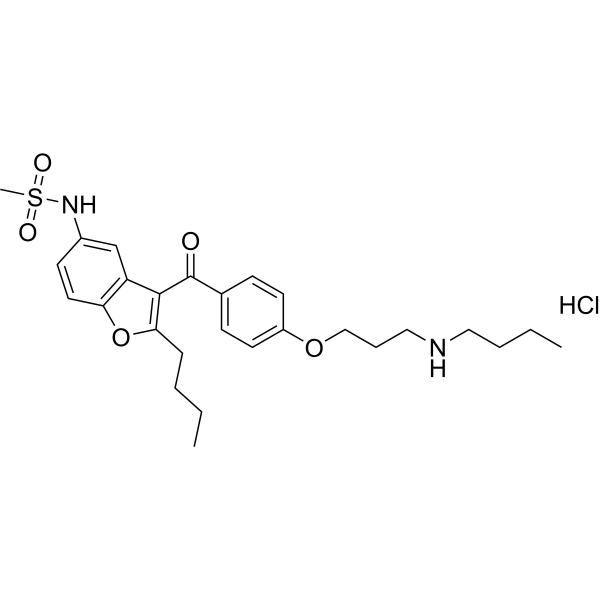
-
- HY-12753AS
-
|
SR35021-d7 hydrochloride
|
Thyroid Hormone Receptor
Isotope-Labeled Compounds
|
Cardiovascular Disease
|
|
Debutyldronedarone-d7 hydrochloride is deuterated labeled Debutyldronedarone hydrochloride (HY-12753A). Debutyldronedarone (SR35021) hydrochloride, the main metabolite of Dronedarone, is a selective thyroid hormone receptor α1 (TRα1) inhibitor. Debutyldronedarone hydrochloride inhibits T3 binding to TRα1 and TRβ1 by 77% and 25%, respectively. Debutyldronedarone hydrochloride can be used for the research of arrhythmic .
|
-
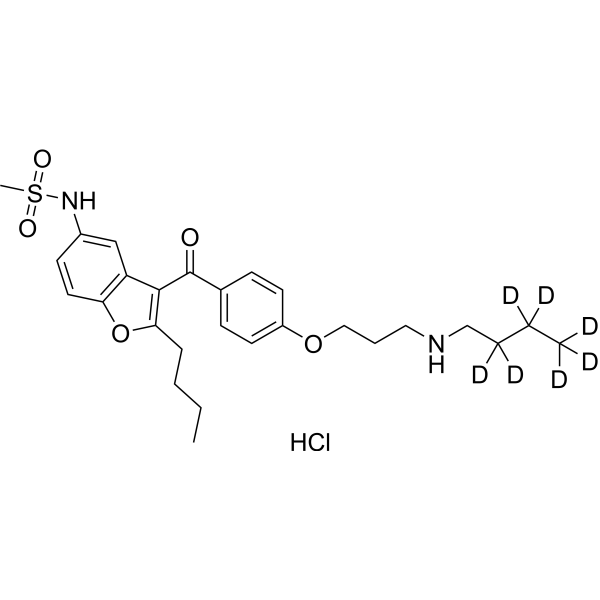
-
- HY-13653
-
|
EGCG; Epigallocatechol Gallate
|
Endogenous Metabolite
Apoptosis
|
Inflammation/Immunology
Cancer
|
|
(-)-Epigallocatechin Gallate (EGCG) is a major polyphenol in green tea, which can inhibit cell proliferation and induce cell apoptosis. (-)-Epigallocatechin Gallate inhibits glutamate dehydrogenase 1/2 (GDH1/2, GLUD1/2) activity. (-)-Epigallocatechin Gallate has a potent anticancer, antioxidant and anti-inflammatory properties against various types of cancers such as colorectal cancer, myeloid leukemia, thyroid carcinoma .
|
-

-
- HY-W009776
-
|
Suberohydroxamic acid; SBHA
|
HDAC
Apoptosis
|
Cancer
|
|
Suberoyl bis-hydroxamic acid (Suberohydroxamic acid; SBHA) is a competitive and cell-permeable HDAC1 and HDAC3 inhibitor with ID50 values of 0.25 μM and 0.30 μM, respectively .Suberoyl bis-hydroxamic acid renders MM cells susceptible to apoptosis and facilitates the mitochondrial apoptotic pathways .Suberoyl bis-hydroxamic acid can be used for the study of medullary thyroid carcinoma (MTC) .
|
-
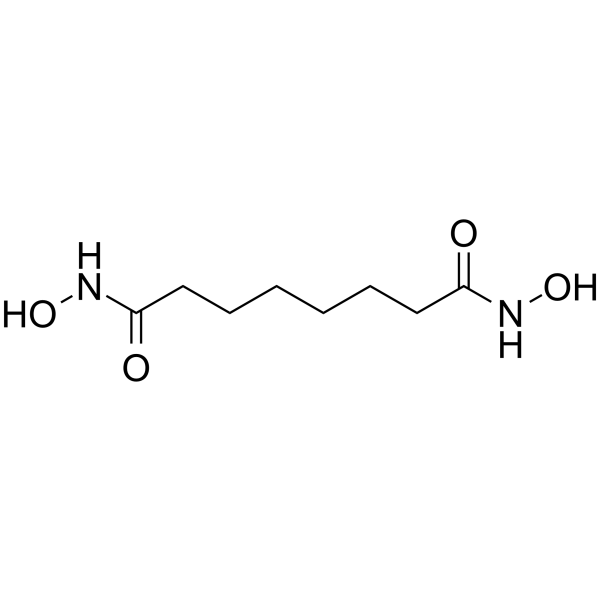
-
- HY-W008452S
-
|
|
Isotope-Labeled Compounds
Endogenous Metabolite
|
Metabolic Disease
|
|
H-Tyr(3-I)-OH- 13C6 is the 13C-labeled H-Tyr(3-I)-OH. H-Tyr(3-I)-OH is a potent and effective tyrosine hydroxylase inhibitor. H-Tyr(3-I)-OH is an intermediate in the production of thyroid hormones and has a role as a human or mouse metabolite[1][2].
|
-
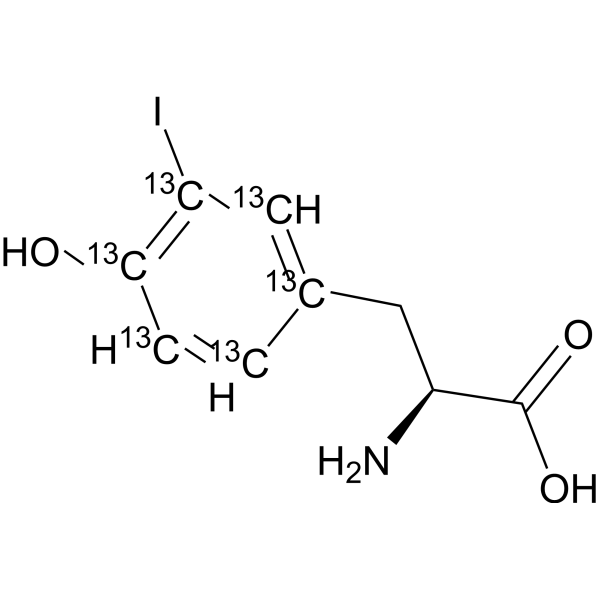
-
- HY-107615
-
|
|
LPL Receptor
|
Cancer
|
|
TC LPA5 4 is a LPA5 (GPR92)-specific non-lipid antagonist. TC LPA5 4 inhibits LPA-induced aggregation of isolated human platelet (LPA5-RH7777 cell line) with an IC50 of 800 nM. TC LPA5 4 displays selectivity for LPA5 over 80 other screened agent targets . TC LPA5 4 inhibits cell proliferation and migration of thyroid cancer cells .
|
-
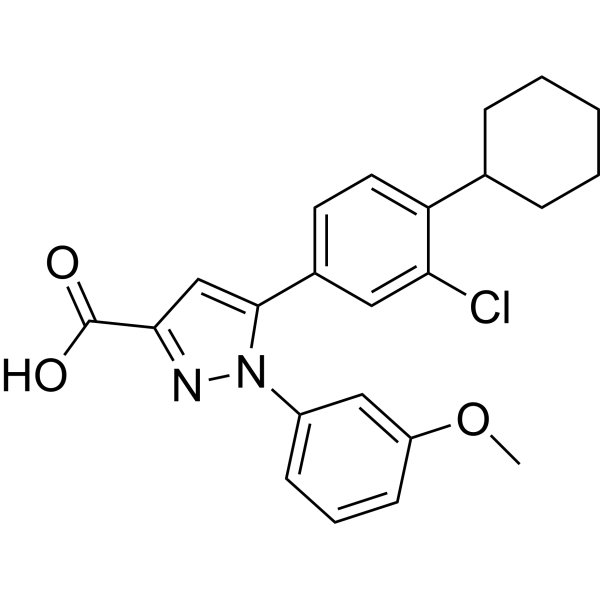
-
- HY-150526
-
|
|
Endogenous Metabolite
Apoptosis
|
Inflammation/Immunology
Cancer
|
|
EGCG-4″-sulfate is a major polyphenol in green tea, which can inhibit cell proliferation and induce cell apoptosis. (-)-Epigallocatechin Gallate sulfate inhibits glutamate dehydrogenase 1/2 (GDH1/2, GLUD1/2) activity. EGCG-4″-sulfate has a potent anticancer, antioxidant and anti-inflammatory properties against various types of cancers such as colorectal cancer, myeloid leukemia, thyroid carcinoma .
|
-

-
- HY-124828
-
|
|
HuR
|
Cancer
|
|
CMLD-2, an inhibitor of HuR-ARE interaction, competitively binds HuR protein disrupting its interaction with adenine-uridine rich elements (ARE)-containing mRNAs (Ki=350 nM). CMLD-2 induces apoptosis exhibits antitumor activity in different cancer cells as colon, pancreatic, thyroid and lung cancer cell lines. Hu antigen R (HuR) is an RNA binding protein, can regulate target mRNAs stability and translation .
|
-
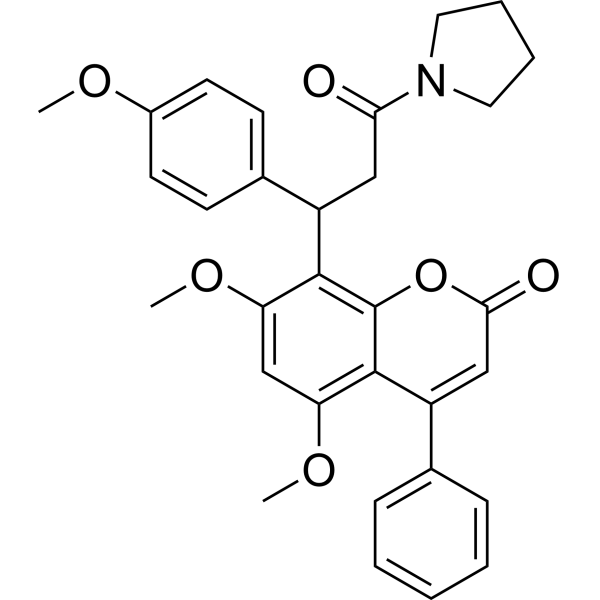
-
- HY-143546
-
|
|
RET
|
Cancer
|
|
RET-IN-9 is a potent inhibitor of RET. RET kinase is a single-pass transmembrane receptor tyrosine kinase that plays an important role in the development of the kidney and enteric nervous system, and the maintenance of homeostasis in the nervous, endocrine, hematopoietic, and male reproductive systems. RET-IN-9 has the potential for the research of RET-related disease including non-small cell lung cancer and medullary thyroid cancer (extracted from patent WO2021115457A1, compound 29) .
|
-
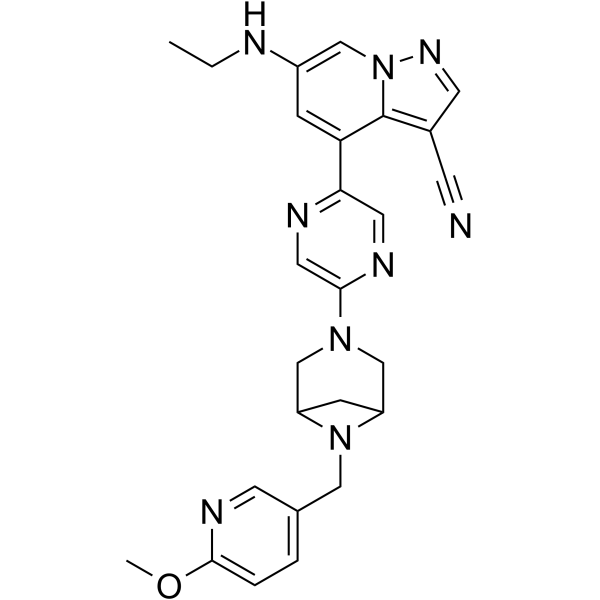
-
- HY-120026
-
|
KB015
|
Thyroid Hormone Receptor
|
Neurological Disease
|
|
KB130015 (KB015) is an orally active and potent ThRα and ThRβ (Thyroid Hormone Receptor) inhibitor, with IC50 values of 4.5 and 5.1 μM, respectively. KB130015 has antiarrhythmic properties. KB130015 markedly slows the kinetics of inactivation of Na + channels. KB130015 opens large-conductance Ca 2+-activated K + channels and relaxes vascular smooth muscle .
|
-
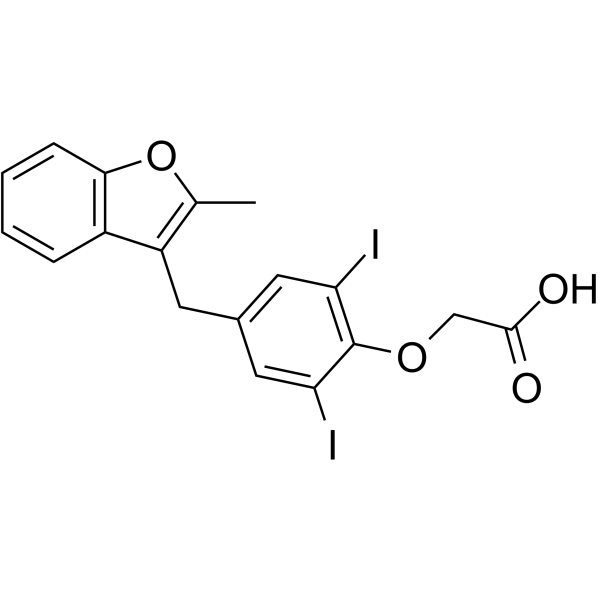
-
- HY-P99165
-
|
|
IGF-1R
TSH Receptor
|
Endocrinology
|
|
Teprotumumab is an IGF-1 receptor (IGF-1R) blocking human monoclonal antibody. Teprotumumab binds to the ligand binding extracellular α-subunit domain of IGF-1R. Teprotumumab inhibits TSH and IGF-1 action in fibrocytes. Teprotumumab attenuates TSH-dependent IL-6 and IL-8 expression and Akt phosphorylation. Teprotumumab can be used for thyroid-associated ophthalmopathy research .
|
-
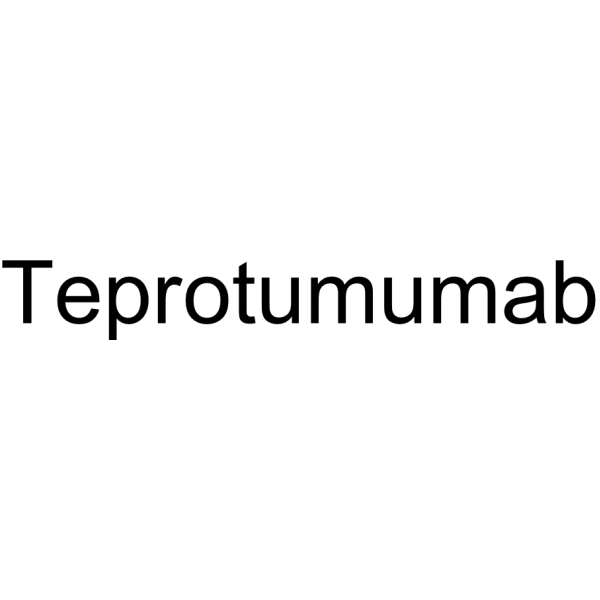
-
- HY-13653R
-
|
EGCG(Standard); Epigallocatechol Gallate (Standard)
|
Endogenous Metabolite
Apoptosis
|
Inflammation/Immunology
Cancer
|
|
(-)-Epigallocatechin Gallate (Standard) is the analytical standard of (-)-Epigallocatechin Gallate. This product is intended for research and analytical applications. (-)-Epigallocatechin Gallate (EGCG) is a major polyphenol in green tea, which can inhibit cell proliferation and induce cell apoptosis. (-)-Epigallocatechin Gallate inhibits glutamate dehydrogenase 1/2 (GDH1/2, GLUD1/2) activity. (-)-Epigallocatechin Gallate has a potent anticancer, antioxidant and anti-inflammatory properties against various types of cancers such as colorectal cancer, myeloid leukemia, thyroid carcinoma .
|
-
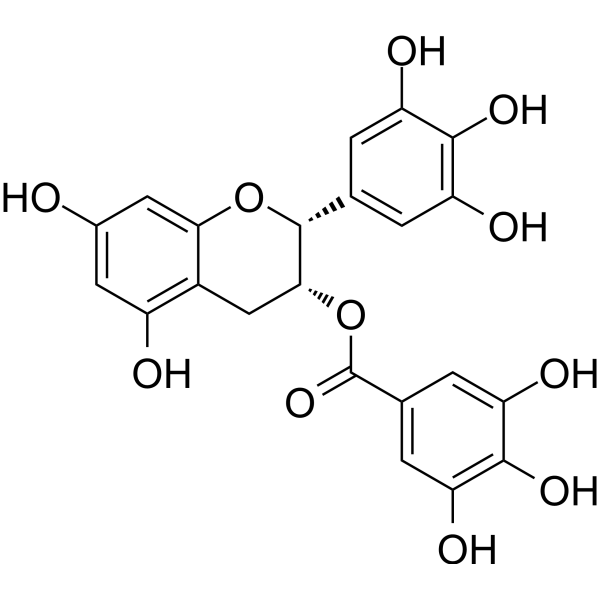
-
-
HY-L126
-
|
|
668 compounds
|
|
Nuclear receptors (NR) are proteins found in cells that sense androgen and thyroid hormones and certain other molecules. They are ligand-activated transcription factors that participate in many aspects of human physiology and pathology, and regulate the expression of various important genes.
Nuclear receptors have become one of the main targets in the development of new drug strategies, providing a unique type of receptors for studying a variety of human diseases, such as breast cancers, skin disorders and diabetes. 13% of U.S. Food and Drug Administration (FDA) approved drugs target nuclear receptors.
MCE supplies a unique collection of 668 nuclear receptor inhibitors and activators, all of which have the identified inhibitory or activated effect on nuclear receptor. MCE Nuclear Receptor Library is a useful tool for drugs research related to cancer, skin disease and diabetes.
|
| Cat. No. |
Product Name |
Target |
Research Area |
-
- HY-W011258
-
|
L-Tyrosyl-L-phenylalanine
|
Xanthine Oxidase
Angiotensin-converting Enzyme (ACE)
|
Inflammation/Immunology
Cancer
|
|
H-Tyr-Phe-OH (L-Tyrosyl-L-phenylalanine) is an orally active inhibitor of Angiotensin converting enzyme (ACE), with an inhibiton rate of 48% at 50 μM. H-Tyr-Phe-OH can be used as an biomarker for differentiating benign thyroid nodules (BTN) from thyroid cancer (TC). H-Tyr-Phe-OH exhibits xanthine oxidase inhibition (uric acid lowering) activity and serves as regulator in IL-8 production in neutrophil-like cells .
|
| Cat. No. |
Product Name |
Target |
Research Area |
-
- HY-P99160
-
|
|
Inhibitory Antibodies
|
Cancer
|
|
Labetuzumab is a humanised anti-carcinoembryonic antigen (CEA) monoclonal antibody that inhibits tumour growth and sensitises human medullary thyroid cancer xenografts to Dacarbazine chemotherapy .
|
-
- HY-P99165
-
|
|
IGF-1R
TSH Receptor
|
Endocrinology
|
|
Teprotumumab is an IGF-1 receptor (IGF-1R) blocking human monoclonal antibody. Teprotumumab binds to the ligand binding extracellular α-subunit domain of IGF-1R. Teprotumumab inhibits TSH and IGF-1 action in fibrocytes. Teprotumumab attenuates TSH-dependent IL-6 and IL-8 expression and Akt phosphorylation. Teprotumumab can be used for thyroid-associated ophthalmopathy research .
|
| Cat. No. |
Product Name |
Category |
Target |
Chemical Structure |
| Cat. No. |
Product Name |
Chemical Structure |
-
- HY-12753AS
-
|
|
|
Debutyldronedarone-d7 hydrochloride is deuterated labeled Debutyldronedarone hydrochloride (HY-12753A). Debutyldronedarone (SR35021) hydrochloride, the main metabolite of Dronedarone, is a selective thyroid hormone receptor α1 (TRα1) inhibitor. Debutyldronedarone hydrochloride inhibits T3 binding to TRα1 and TRβ1 by 77% and 25%, respectively. Debutyldronedarone hydrochloride can be used for the research of arrhythmic .
|
-

-
- HY-W008452S
-
|
|
|
H-Tyr(3-I)-OH- 13C6 is the 13C-labeled H-Tyr(3-I)-OH. H-Tyr(3-I)-OH is a potent and effective tyrosine hydroxylase inhibitor. H-Tyr(3-I)-OH is an intermediate in the production of thyroid hormones and has a role as a human or mouse metabolite[1][2].
|
-

Your information is safe with us. * Required Fields.
Inquiry Information
- Product Name:
- Cat. No.:
- Quantity:
- MCE Japan Authorized Agent:







































